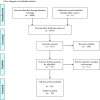Physical activity interventions to promote positive youth development among indigenous youth: a RE-AIM review
- PMID: 27443642
- PMCID: PMC5352641
- DOI: 10.1007/s13142-016-0428-2
Physical activity interventions to promote positive youth development among indigenous youth: a RE-AIM review
Abstract
Physical activity (PA) programs are a promising strategy to promote positive youth development (PYD). It is not known if published reports provide sufficient information to promote the implementation of effective PYD in indigenous youth. The purpose of this study was to assess the extent to which published literature on PA programs that promote PYD in indigenous youth report on RE-AIM (reach, effectiveness, adoption, implementation, maintenance) indicators. A systematic literature search was conducted to identify articles reporting on PA programs that promote PYD in indigenous youth. The search yielded 8084 articles. A validated 21-item RE-AIM abstraction tool assessing internal and external validity factors was used to extract data from 10 articles meeting eligibility criteria. The most commonly reported dimensions were effectiveness (73 %), adoption (48 %), and maintenance (43 %). Reach (34 %) and implementation (30 %) were less often reported. Published research provides insufficient information to inform real-world implementation of PA programs to promote PYD in indigenous youth.
Keywords: Aboriginal youth; External validity; Implementation; Knowledge translation.
Conflict of interest statement
Compliance with ethical standards
This article does not contain any studies with human participants or animals performed by any of the authors. This article reports on information extracted from published research articles; IRB approval was not required.
Conflict of interest
The authors declare that they have no competing interests.
Similar articles
-
Rural physical activity interventions in the United States: a systematic review and RE-AIM evaluation.Int J Behav Nutr Phys Act. 2019 Dec 27;16(1):140. doi: 10.1186/s12966-019-0903-5. Int J Behav Nutr Phys Act. 2019. PMID: 31882013 Free PMC article.
-
Interventions to improve physical activity during pregnancy: a systematic review on issues of internal and external validity using the RE-AIM framework.BJOG. 2017 Mar;124(4):573-583. doi: 10.1111/1471-0528.14276. Epub 2016 Aug 30. BJOG. 2017. PMID: 27571933 Review.
-
What is the State of the Science on Physical Activity Interventions for Family Caregivers? A Systematic Review and RE-AIM Evaluation.J Phys Act Health. 2017 Jul;14(7):578-595. doi: 10.1123/jpah.2016-0280. Epub 2017 Mar 14. J Phys Act Health. 2017. PMID: 28290737 Review.
-
Using the RE-AIM framework to evaluate physical activity-based fall prevention interventions in older adults with chronic conditions: A systematic review.Transl Behav Med. 2023 Jan 20;13(1):42-52. doi: 10.1093/tbm/ibac072. Transl Behav Med. 2023. PMID: 36394349
-
[Assistance programs for physical activity in Brazilian schools: a review based on the RE-AIM model].Cien Saude Colet. 2019 Sep 9;24(9):3443-3456. doi: 10.1590/1413-81232018249.23502017. Cien Saude Colet. 2019. PMID: 31508762 Review. Portuguese.
Cited by
-
Rural physical activity interventions in the United States: a systematic review and RE-AIM evaluation.Int J Behav Nutr Phys Act. 2019 Dec 27;16(1):140. doi: 10.1186/s12966-019-0903-5. Int J Behav Nutr Phys Act. 2019. PMID: 31882013 Free PMC article.
-
Implementation models and frameworks used to guide community-based physical activity programs for children: a scoping review.BMC Public Health. 2023 Aug 23;23(1):1604. doi: 10.1186/s12889-023-16465-2. BMC Public Health. 2023. PMID: 37612686 Free PMC article.
-
Informing the Physical Activity Evaluation Framework: A Scoping Review of Reviews.Am J Health Promot. 2022 Feb;36(2):340-366. doi: 10.1177/08901171211050059. Epub 2021 Dec 6. Am J Health Promot. 2022. PMID: 34872359 Free PMC article.
-
Physical activity promotion and translational research.Transl Behav Med. 2017 Mar;7(1):1-2. doi: 10.1007/s13142-016-0456-y. Transl Behav Med. 2017. PMID: 28032316 Free PMC article. No abstract available.
-
Implementation processes of social network interventions for physical activity and sedentary behavior among children and adolescents: a scoping review.BMC Public Health. 2024 Apr 22;24(1):1101. doi: 10.1186/s12889-024-18615-6. BMC Public Health. 2024. PMID: 38649855 Free PMC article.
References
-
- Mayeda D, Chesney-Lind M, Koo J. Talking story with Hawai’i’s youth: confronting violent and sexualized perceptions of ethnicity and gender. Youth Soc. 2001;33:99–128. doi: 10.1177/0044118X01033001004. - DOI
-
- Kana’iaupuni SM. Ka’akālai Kū kanaka: a call for strengths-based approaches from a native Hawaiian perspective. Educ Res. 2005;34:32–38. doi: 10.3102/0013189X034005032. - DOI
-
- Crooks CV, Chiodo D, Thomas D, Hughes R. Strengths-based programming for First Nations youth in schools: building engagment through healthy relationships and leadership skills. Int J Ment Heal Addict. 2009;8:160–173. doi: 10.1007/s11469-009-9242-0. - DOI
Publication types
MeSH terms
Grants and funding
LinkOut - more resources
Full Text Sources
Other Literature Sources
Medical


